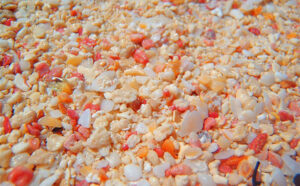Our Unique Pink Sand

Source: The Royal Gazette
Pink sand. It makes Bermuda’s beaches some of the most beautiful and picturesque in the world…but what makes it pink?
Although some people believe the sand’s colouration is just a trick of the eye caused by the warm glow of the setting sun, there is a scientific explanation as to why some of Bermuda’s beaches actually do have pink-hued sands and the answer rests with marine organisms known as “foraminifera.”
Foraminifera (or “forams” for short) are single-celled marine organisms with shells, called “tests”, that are made of calcium carbonate, the same material found in the shells of other marine organisms such as corals, lobsters and mussels. Forams are not considered animals because they do not have bodies that are divided up into multiple cells; however, they are also not quite plants because they don’t photosynthesize like plants and algae.
As a result, foraminifera are classified separately from both plants and animals in a group called protists. Protists are found in most freshwater and saltwater environments and they often play an important role as primary producers.
This is true in the ocean, where forams are one of the most abundant species of marine plankton. Scientists estimate that more than 4,000 species of forams exist in the world’s oceans, with only about 10 percent of these (40 species) living in the water column as free-swimming organisms. The majority of foraminifera species live at the bottom of the ocean, growing in plants, sand and other benthic substrates.
Most forams are quite small, averaging less than 1mm in size, but some species such as the giant Antarctic foram Astrammina rara can grow to over 10mm (1cm) in length, which is about the width of an average adult fingernail!
One common feature of foraminifera is the presence of pseudopodia (“false feet”). Each foram has holes in its test through which it extends tentacles or pseudopodia to feed. The pseudopodia form a dense network that extends from the organism and acts as a web to catch food, which the foram then engulfs and digests.
Many forams have symbiotic algae within their shells similar to zooxanthellae, the symbiotic algae that lives within coral skeletons. “Symbiotic” means that both the host organism (the foram or coral) and the algae benefit from the close association. In the case of forams, the algae get the benefit of a place to live and grow (ie, the forams’ tests) and the forams get food by digesting the waste products of the algae. Scientists believe these symbiotic algae are what give the red forams their distinctive colouration.
In Bermuda, one particular species of red foraminifera, Homotrema rubrum, grows abundantly on the undersides of coral ledges. When the forams die, either naturally or from the crushing forces of wave action, their tests sink to the bottom. Over time, tidal forces and waves wash these tests ashore, where they mix with the white crushed skeletons of other marine organisms, giving the sand a pink hue.
Despite their small size, foraminifera play an important role in geologic sciences. Because they have a calcium carbonate shell, forams are well-preserved in the fossil record. Combined with their abundance in the ocean, this gives scientists an accurate record of the evolution of forams, as well as a reliable way to date the age of the surrounding substrate.
So, the next time someone asks about Bermuda’s famous pink sand, you can tell them our beaches get their beautiful colour because of a very small marine organism: the red foraminifera. And, while you’re at it, here are two interesting facts you can share about forams:
Foraminifera were collected during the famous 1872 HMS Challenger expedition, which was the world’s first marine research expedition.
The limestone used to build the Great Pyramids of Egypt is composed primarily of benthic foraminifera.
